 From 1991 to 2001, the disintegration of Yugoslavia caused a series of wars particularly deadly against a background of exacerbated nationalism. Yugoslavia , a kingdom created in 1918, had become a federal state after the Second World War. It then comprised six Republics:Slovenia, Croatia, Bosnia and Herzegovina, Montenegro, Serbia and Macedonia and two autonomous States:Vojvodina and Kosovo. The Yugoslav federation broke up from 1991:independence of Croatia, Slovenia and Macedonia in 1991, then of Bosnia and Herzegovina in 1992. The two remaining states formed the Federal Republic of Yugoslavia (Serbia and Montenegro), before separating in turn in 2006. The ten years of war in the former Yugoslavia claimed more than 100,000 victims and displaced 4 million refugees.
From 1991 to 2001, the disintegration of Yugoslavia caused a series of wars particularly deadly against a background of exacerbated nationalism. Yugoslavia , a kingdom created in 1918, had become a federal state after the Second World War. It then comprised six Republics:Slovenia, Croatia, Bosnia and Herzegovina, Montenegro, Serbia and Macedonia and two autonomous States:Vojvodina and Kosovo. The Yugoslav federation broke up from 1991:independence of Croatia, Slovenia and Macedonia in 1991, then of Bosnia and Herzegovina in 1992. The two remaining states formed the Federal Republic of Yugoslavia (Serbia and Montenegro), before separating in turn in 2006. The ten years of war in the former Yugoslavia claimed more than 100,000 victims and displaced 4 million refugees.
What is Yugoslavia?
The former Yugoslavia finds its source at the end of the First World War. The allied victors create from scratch a new state in the Balkans on the ruins of the Austro-Hungarian empire which aims to unify the southern Slavs. Thus was born the kingdom of Serbs, Croats and Slovenes. Several successive treaties fixed its borders and in 1921, the kingdom acquired a centralist and parliamentary constitution. In 1929, Alexander I established an authoritarian regime and his country took the name of Kingdom of Yugoslavia. The sovereign was assassinated by a Croatian extremist in 1934. At the start of the Second World War, Yugoslavia remained neutral. But the regent Paul, who exercises power in the name of Peter II, signs the tripartite pact with Germany. He is overthrown by a revolution in Belgrade and Nazi Germany invades and occupies the country until the end of the war. Nationalist, royalist and communist resistance fighters opposed each other as much as the occupier.
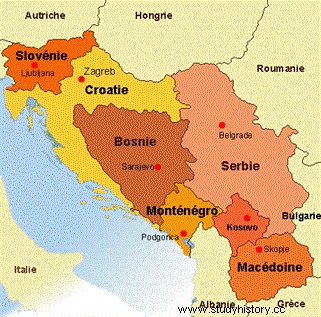 The second Yugoslavia was born after the Second World War, following the victory of the Communists of Tito who control the entire Yugoslavian territory from May 1945. Tito sets up a communist regime (which will have the particularity of remaining independent vis-à-vis Moscow from 1948 after the break with Stalin) and unifies the former Kingdom of Yugoslavia in a federation of 6 "democratic" states:Slovenia (Ljubljana), Croatia (Zagreb), Montenegro (Titograd, now Podgorica), Bosnia-Herzegovina (Sarajevo), Macedonia (Skopje) and Serbia (Belgrade) including the autonomous provinces of Kosovo (Pristina) and Vojvodina (Novi Sad).
The second Yugoslavia was born after the Second World War, following the victory of the Communists of Tito who control the entire Yugoslavian territory from May 1945. Tito sets up a communist regime (which will have the particularity of remaining independent vis-à-vis Moscow from 1948 after the break with Stalin) and unifies the former Kingdom of Yugoslavia in a federation of 6 "democratic" states:Slovenia (Ljubljana), Croatia (Zagreb), Montenegro (Titograd, now Podgorica), Bosnia-Herzegovina (Sarajevo), Macedonia (Skopje) and Serbia (Belgrade) including the autonomous provinces of Kosovo (Pristina) and Vojvodina (Novi Sad).
This State formed in November 1945 leaves their autonomy to the different republics in terms of language and administrative personnel but remains strong and centered on Belgrade to ensure the link between the different parts of this ethnic, cultural and religious mosaic. Croatia, Catholic, has a large Serbian Orthodox minority. Serbia, Orthodox, populated mainly by Serbs, has Muslim, Catholic, Hungarian (in Vojvodina), Albanian (and Albanian-speaking) minorities in Kosovo. Bosnia is split between Bosniaks (48%), Serbs (37%) and Croats (13%). Note that Bosnian is the kindred for the people of Bosnia, Bosnian denotes a Bosnian Muslim.
At the death of Tito on May 4, 1980, following a long agony, the government is ensured by a rotating presidency between each republic, by mandate of 1 year. Tito left an economy in a sorry state:foreign debt of 20 billion dollars, drop in purchasing power, galloping 3-digit inflation... The country was plagued by strong ethnic and social tensions:from 1981, the Albanians of Kosovo claim the independence of their province, serious riots break out. In 1989, the country suffered a general strike which paralyzed the economy.
The rise of nationalisms
It was in this context that in 1986 Slobodan Milosevic, son of an Orthodox priest and a teacher, graduated from the Faculty of Law in Belgrade, director of the Bank of Belgrade until 1983, he became head of the communist section of Belgrade the following year. He begins a strong criticism of the bureaucratic system and supports social reform projects. His vision is also nationalist and agitates the old Pan-Serbian ideas which aim to bring together all the Serbian minorities in the same territory:Greater Serbia.
Thus, he violently condemns the Albanian agitations in Kosovo (an independent province of Serbia), purges the Kosovar communist apparatus and has a measure voted in reinstating this province and that of Vojvodina in the territory Serbian. In addition, he supports the demonstrations of Serb minorities in Croatia and Bosnia. By blowing on the embers of Serbian nationalism, which are just waiting to start again, it is exacerbating inter-ethnic tensions. In Slovenia, a multiparty system was authorized in 1989, followed by Croatia in 1990.
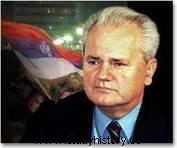 May 7, 1990, the first free elections in Croatia saw the victory of the Croatian Democratic Union and its leader Franjo Tudjman. Sentenced to 3 years in prison for "nationalist activities" for having asserted, among other things, that Bosnians are Muslim Croats who will naturally return to Croatia once freed from communism, he is one of the major figures, with Milosevic, of the rise of nationalisms.
May 7, 1990, the first free elections in Croatia saw the victory of the Croatian Democratic Union and its leader Franjo Tudjman. Sentenced to 3 years in prison for "nationalist activities" for having asserted, among other things, that Bosnians are Muslim Croats who will naturally return to Croatia once freed from communism, he is one of the major figures, with Milosevic, of the rise of nationalisms.
Why did Yugoslavia break up?
In fact, the Communist Party of Yugoslavia is nothing more than an empty shell at the federal level. In January 1990, he scuttled himself by decreeing the transition to a mixed economy and the end of authoritarianism. Pandora's box is open:Slovenia organizes elections in April, where the communists are beaten soundly by the opposition parties. Croatia, as we have seen, sees the arrival of Tudjman. Croatian Serbs are stepping up public protests. In Serbia, Milosevic is elected President of the Socialist Republic of Serbia by universal suffrage.
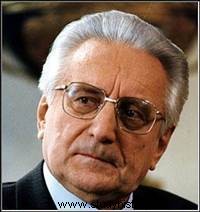 Bosnia and Herzegovina sees the Democratic Action Party of Muslim leader Alija Izetbegovic win . In Macedonia, it is the nationalists who dominate. Thus the federal government of Yugoslavia, still in operation, has in fact no longer any existence or any power. On the other hand, the federal army, the JNA, dominated by Serbs, still exists and keeps watch.
Bosnia and Herzegovina sees the Democratic Action Party of Muslim leader Alija Izetbegovic win . In Macedonia, it is the nationalists who dominate. Thus the federal government of Yugoslavia, still in operation, has in fact no longer any existence or any power. On the other hand, the federal army, the JNA, dominated by Serbs, still exists and keeps watch.
The separation will be fully consummated on June 25, 1991. While Slovenia had announced it for June 26, it declared its independence a day earlier, taking the federal army and Belgrade. It is followed the same day by Croatia. Belgrade reacts by sending troops:it is the beginning of a murderous conflict which will last 10 years. A federal republic of Yugoslavia (Serbia and Montenegro) was proclaimed in April 1992 until its dissolution in June 2006.
Slovenian secession
Slovenia is a pioneer in the dissolution of Yugoslavia. On December 23, 1990, while still an integral part of Yugoslavia, it organized a referendum for its separation from the federation. The "yes" wins by more than 80%. Consequently, the separation is announced by the Slovenian authorities for June 26, 1991. Of course, in Ljubljana one suspects that the central power will not remain without reaction. Not to preserve the integrity of the territory or for nationalist reasons (there are practically no ethnic minorities in Slovenia, more than 80% populated by Slovenes), but not to be destabilized.
Indeed, Slovenia occupies a strategic position. It is on the border with Austria and Italy, it is the gateway to the West and therefore a considerable asset given its cultural proximity to its rich Austrian neighbor and its overall economy in better health than that of the other republics. of the federation.
During the Tito era, internal defense policy operated on 2 levels. The central power had the JNA, the Yugoslav federal army, and each republic had autonomous forces, the Territorial Defense, comparable to police forces, much less well armed and trained than the JNA. Nevertheless, Slovenia is preparing from December to face the military reaction of Belgrade. It buys weapons secretly abroad and sets up defense plans close to the guerrillas, taking into account its material and numerical inferiority, based on specific interventions, on strategic points, with light units and very mobile.
The war in Yugoslavia
Slovenia declares its independence on June 25, 1991, one day before the official communiqués, in order to create a strategic advantage over the JNA which is preparing to intervene for the 26th. Belgrade is thus taken aback. During this period, the Slovenian forces occupied the border posts and the airport of Brnik (Ljubljana), strategic positions allowing them to protect themselves from a regular attack by the JNA. In Belgrade, we are still hesitating about the nature of the intervention:the military advocates the strong way, want to drive out the Slovenian leaders and set up a friendly government. Politicians want a show of force, hoping to scare the Slovenian government. Still, the Slovenians now have the upper hand. Faced with a fait accompli, if the JNA opens fire, the Federal State will be designated as an aggressor in the eyes of international opinion. Thus, from the departure of the Yugoslav troops from their barracks, on June 26 and 27, each camp is observed as earthenware dogs.
 Nevertheless, the JNA being the federal army, it has barracks all over the territory, even in Slovenia, which allows him to regain ground quickly. From the 27th, it retook Brnik airport, the air force flew over Ljubljana, and armored vehicles headed for the border posts. From then on, the Slovenian government took the decision to use force. He issued an ultimatum to Belgrade, which was transporting elite troops by helicopter, telling him that the overflight of his territory had to cease, otherwise the aircraft would be shot down. The warning not being taken seriously, Slovenian forces shoot down 2 helicopters over Ljubljana. The Yugoslav bases in Slovenian territory are surrounded, the armored convoys are attacked. Despite everything, the JNA manages to maintain its positions.
Nevertheless, the JNA being the federal army, it has barracks all over the territory, even in Slovenia, which allows him to regain ground quickly. From the 27th, it retook Brnik airport, the air force flew over Ljubljana, and armored vehicles headed for the border posts. From then on, the Slovenian government took the decision to use force. He issued an ultimatum to Belgrade, which was transporting elite troops by helicopter, telling him that the overflight of his territory had to cease, otherwise the aircraft would be shot down. The warning not being taken seriously, Slovenian forces shoot down 2 helicopters over Ljubljana. The Yugoslav bases in Slovenian territory are surrounded, the armored convoys are attacked. Despite everything, the JNA manages to maintain its positions.
The decline of the federal army
The general offensive was launched on the 28th by the Slovenes, wherever they had a strategic advantage. The JNA retained most of its positions, bombed targets such as Brnik airport, radio and television stations, but faced internal difficulties:Slovenian JNA soldiers fled to join the Slovenian forces.
On the 29th, Slovenian forces recaptured Brnik airport, seized armored vehicles. In order to avoid a murderous escalation, Ljubljana is asking for a diplomatic way out of the crisis. The skirmishes continue the following days almost everywhere, and we begin to see Yugoslav troops surrender.
 Belgrade realizes the ineffectiveness of its reconquest strategy and prepares to launch a general attack, at the great dismay of the head of the JNA who had advocated this type of intervention from the start. Despite everything, the JNA suffers bitter setbacks, more and more troops are forced to surrender, the results are disastrous. Attempts at border counterattacks are repelled.
Belgrade realizes the ineffectiveness of its reconquest strategy and prepares to launch a general attack, at the great dismay of the head of the JNA who had advocated this type of intervention from the start. Despite everything, the JNA suffers bitter setbacks, more and more troops are forced to surrender, the results are disastrous. Attempts at border counterattacks are repelled.
On the evening of July 2, a ceasefire is requested by Ljubljana. At the same time, a large armored convoy is sent in the direction of Slovenia, but will never arrive there, officially because of mechanical problems. In reality, it is very likely that the armored vehicles were sent in order to prevent the disturbances likely to occur in Croatia, which declared its independence on June 25, just after Slovenia.
The independence of Slovenia
The ceasefire is accepted by the JNA, which withdraws and lets the Slovenian forces regain control of the various bases and border posts. On July 7, the Brioni Accords seal the end of hostilities and recognize the Slovenian state, as well as the sovereignty of its police and military forces over the territory.
Because of its short duration and low intensity, the conflict generated few human losses (less than a hundred dead for both sides) and material destruction was moderate. Slovenia was recognized as a country in its own right by Europe in January 1992 and joined the UN in May 1992. With the secession of Croatia, Belgrade's policy of maintaining a Slavic state was shattered and refocused now on Serbian nationalism which aims to establish Greater Serbia and unite all Serbs in a single state, and will lead to a far more violent conflict in Croatia.
Croatia is on fire
The Serbs of Croatia, fearing to find themselves in the minority in an independent state, and very marked by the memory of the abuses of the Ustashi during the Second World War, proclaimed after a referendum the autonomy of the Krajina of Knin (where they are in the majority) and its attachment to Serbia. Belgrade's support for this secessionist attempt is causing serious tensions with the Zagreb government, led by Franjo Tudjman.
Affirming the right of all Serbs (including those from other republics) to live in the same state and challenging the constitutionality of the double secession, Belgrade sends the federal army to Slovenia and Croatia. Under pressure from the European Union, which threatens to immediately recognize the new states, Serbia agrees on July 18 to withdraw the army from Slovenia after two weeks of fighting, while the two secessionist republics agree to a three-month moratorium in their Declaration of Independence.
 In Croatia, the federal army refuses to withdraw while inter-ethnic clashes multiply, causing several dozen dead and causing the first exoduses of Serbs and Croats, in Slavonia and Banija. The fighting between the Serbian militiamen, supported by the federal army, and the Croatian forces, continued and worsened, despite the attempt at European mediation led by Lord Carrington. The Republic of Serbian Krajina extends its control to 20%. 100 from Croatia. With the siege and the bombardment of Vukovar (conquered on November 19), then of Dubrovnik (October-November) by the Serbs, international opinion became aware that a real war was going to set the old federation ablaze.
In Croatia, the federal army refuses to withdraw while inter-ethnic clashes multiply, causing several dozen dead and causing the first exoduses of Serbs and Croats, in Slavonia and Banija. The fighting between the Serbian militiamen, supported by the federal army, and the Croatian forces, continued and worsened, despite the attempt at European mediation led by Lord Carrington. The Republic of Serbian Krajina extends its control to 20%. 100 from Croatia. With the siege and the bombardment of Vukovar (conquered on November 19), then of Dubrovnik (October-November) by the Serbs, international opinion became aware that a real war was going to set the old federation ablaze.
On September 25, 1991, the UN Security Council proclaimed an arms sales embargo in Yugoslavia and then, on November 23, affirmed its intention to send Blue helmet. The recognition of Slovenia and Croatia by Germany on December 23 precedes that of the rest of the international community by one month. In Macedonia, 95 p. 100 of voters voted in favor of independence, proclaimed on September 15, 1991.
An unconditional ceasefire was signed in January 1992, without the Zagreb government acknowledging the loss of Krajina (to the south) and Slavonia (to the 'is). On February 21, 1992, the Security Council voted for the deployment of 14,000 blue helmets in Croatia, mostly French and English, from whom the Serbs hoped for de facto recognition of their conquests. But the attention of the international community has shifted to Bosnia and Herzegovina...
Bosnia and Herzegovina at war
In March 1992, Bosnia and Herzegovina in turn declared its independence, recognized by the United States in April 1992, then by the United Nations in May 1992 , which does not prevent the conflict from spreading. The war began with the siege of Sarajevo in April 1992, all nationalities taking part. The horror of the massacres linked to the “ethnic cleansing” practiced by the Serbs (and to a lesser extent by the Croats and the Muslims) provoked a massive exodus of the population and 200,000 victims. International intervention is long and difficult to set up.
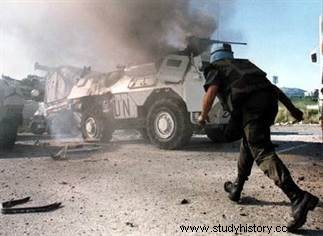 The United Nations sends Blue Helmets (UNPROFOR) to the field, responsible for maintaining peace and carrying out a humanitarian mission with civilian populations. This force, mainly made up of British and French, had an ambiguous role and was gradually considered to be a party to the conflict. At the end of 1994, the security zones controlled by the UN were threatened by the Serbs, without the forces NATO peacekeepers and air forces appear capable of genuinely influencing the fighting, despite the bombardment of Serb positions.
The United Nations sends Blue Helmets (UNPROFOR) to the field, responsible for maintaining peace and carrying out a humanitarian mission with civilian populations. This force, mainly made up of British and French, had an ambiguous role and was gradually considered to be a party to the conflict. At the end of 1994, the security zones controlled by the UN were threatened by the Serbs, without the forces NATO peacekeepers and air forces appear capable of genuinely influencing the fighting, despite the bombardment of Serb positions.
The Dayton Accords, signed on November 21, 1995 and ratified a month later in Paris, put an end to the Yugoslav conflict. They formalize the partition of Bosnia and Herzegovina into two confederate entities, the Croat-Muslim Federation and the Serbian Republic, which have central institutions; Sarajevo is the capital of the Bosnian state. However, all the problems, especially those caused by population displacements, have not been solved and the country seems to have divided along ethnic fault lines, with no community trusting the others.
A fragile peace in the former Yugoslavia
The viability of the new state, the day after the entry into force of the Dayton agreements, largely depends on the still tense relations between Croats and Muslims within their common entity. The return of refugees and the trial of those responsible for war crimes by the International Criminal Tribunal in The Hague, created in February 1993 (in particular the Serbian leaders Karadžić and Mladić) constitute the two other major threats to the peace agreements.
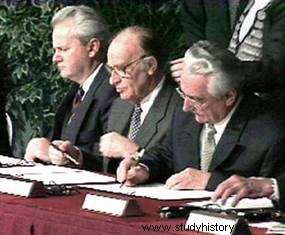 From a diplomatic point of view, the war revealed the inability of Europeans to manage an international crisis together , due to the lack of institutions provided for this purpose and the differences between the partners. The Germans are accused of having recognized the new republics too quickly without having obtained guarantees for the respect of the rights of the minorities, while the French, traditionally close to the Serbs, were slow to recognize them as aggressors.
From a diplomatic point of view, the war revealed the inability of Europeans to manage an international crisis together , due to the lack of institutions provided for this purpose and the differences between the partners. The Germans are accused of having recognized the new republics too quickly without having obtained guarantees for the respect of the rights of the minorities, while the French, traditionally close to the Serbs, were slow to recognize them as aggressors.
The activity of Europeans in favor of peace has mainly been carried out within the contact group bringing together Germany, the United States, France, the United Kingdom and Russia. First accused of having easily accepted the partition of Bosnia and Herzegovina, their work eventually served as the basis for the Dayton Accords. Once the peace was signed, the Europeans undertook to participate in the financing of the reconstruction of the country. The ambiguities of the UN, whose humanitarian intervention quickly proved to be a trap, considerably damaged its image.
To go further on the war in Yugoslavia
- The Disintegration of Yugoslavia and the Emergence of Seven Successor States:1986-2013, by Reneo Lukic. Editions Hermann, 2014.
- Life and Death of Yugoslavia, by Paul Garde. Fayard, 2000.
- Last Balkan War? Ex-Yugoslavia:testimonies, analyses, perspectives, by Jean Cot. Editions L'Harmattan, 2000.
